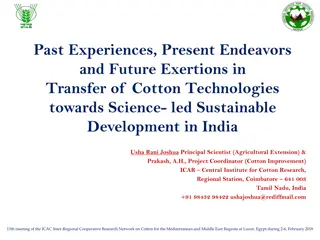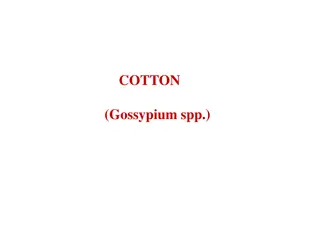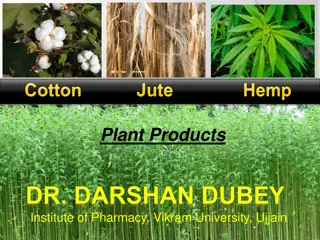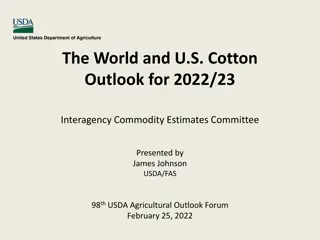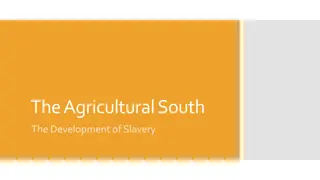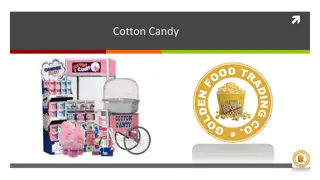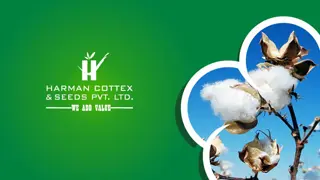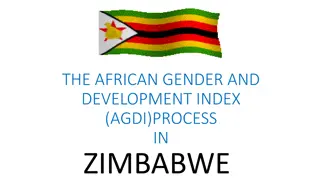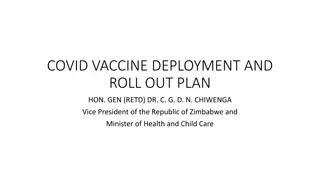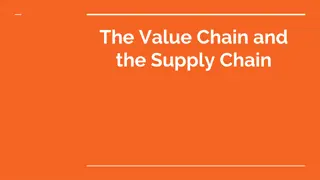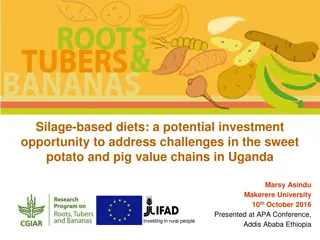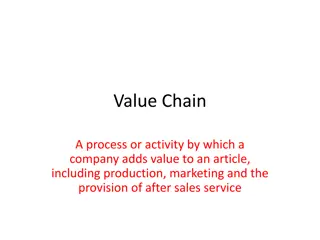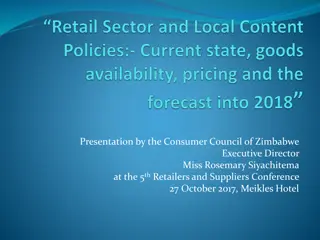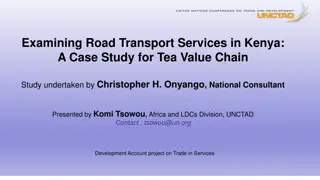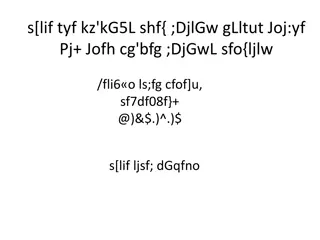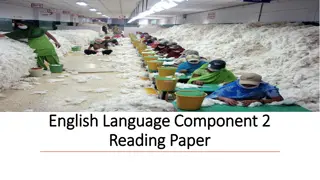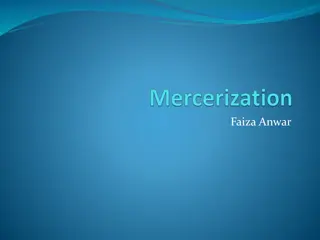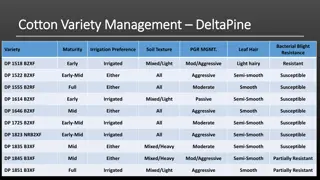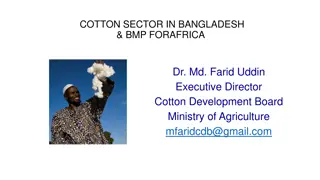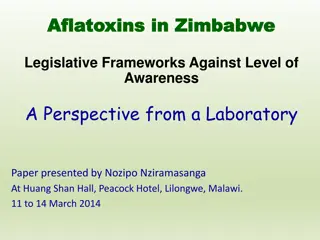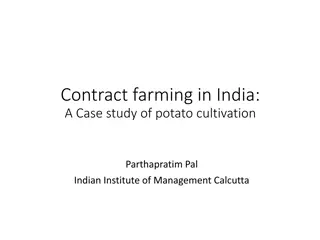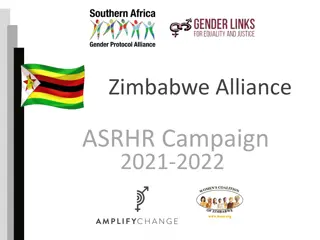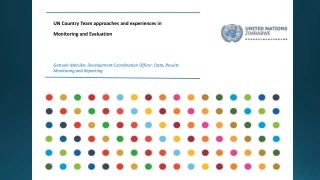Overview of Cotton Production and Value Chain in Zimbabwe
Cotton production in Zimbabwe plays a crucial role in improving rural livelihoods and the economy. Over 200,000 smallholder farmers are engaged in cotton production, making it a significant source of income, employment, and export earnings. The cotton value chain involves various players like farmers, merchants, ginners, textile companies, and regulatory bodies. The sector faces challenges that need to be addressed to ensure its sustainability and growth.
Download Presentation

Please find below an Image/Link to download the presentation.
The content on the website is provided AS IS for your information and personal use only. It may not be sold, licensed, or shared on other websites without obtaining consent from the author. Download presentation by click this link. If you encounter any issues during the download, it is possible that the publisher has removed the file from their server.
E N D
Presentation Transcript
AGRICULTURAL MARKETING AUTHORITY Marketing & Economic Research Department
Outline of Presentation Importance of cotton production in Zimbabwe Structure of the cotton industry Players in the cotton sector Cotton production trends Cotton producer prices The role of AMA in regulating the cotton sector Key issues affecting the cotton sector National strategies in the cotton sector
Importance of Cotton Production in Zimbabwe Cotton remains an important crop for improving rural livelihoods. It is a drought tolerant crop that is most suitable in semi-arid areas of Zimbabwe. The crop is grown by over 200 000 smallholder farmers. It is a major source of livelihood for approximately 600 000 people, including farmers, farm workers, their families and industrial workers. It contributes immensely to income, employment and export earnings. It is a source of raw material for the textile and oil expressing industry. The stockfeed industry relies on cotton cake for the manufacture of animal feed.
THE COTTON VALUE CHAIN IN ZIMBABWE Merchants and Ginners SEED COTTON PRODUCTION Spinning Factories Knitting Policy & Regulatory Services Min of Agriculture AMA DR&SS Cotton Company of Zimbabwe Textiles Zim Spinners & Weavers David Whitehead Twine & Cordage SinoZim Sumberero Twine and Allied Garment Manufacture China Africa Cotton Hosiery Research Cotton Research Instititute Quton Health & hygiene Southern Cotton Extension Services Agritex Famers Unions Ginners 200 000 Farmers Vegetable oil Cotton seed processors Alliance Consumers Agrochemical and fertiliser Companies Stock feed manuf. Linters Surface Wilmar United Refineries Olivine ETG Parrogate Alliance Cangrow Grafax Grafax Cotton meal and cake Water, electricity, fuel ETG Labour force Parrogate
Key Players in Cotton Production Farmer Organizations Farmers Service Providers AMA Regulatory function Cotton Research Institute Research Services Division Agritex Ministry of Lands and Agriculture Ministry of Industry & Commerce Input suppliers 3 Farmer Unions are actively involved in cotton production - ZFU, ZCFU and ZNFU. Independent farmer groups also get involved in cotton production and marketing. over 200 000 smallholder farmers involved in cotton production
Key Players in Cotton Value Addition Five Contractors/Ginners and their Areas of operation Cottco countrywide ETG Parrogate Masvingo, Manicaland China Africa Gokwe, Sanyati Alliance - Gokwe, Sanyati, Kadoma Southern Cotton Mbire, Muzarabani, Rushinga. Makonde, Sanyati, Kadoma, Gokwe National Ginning Capacity 600 000t Average ginning outurn 41% lint; 58% cotton seed ZITMA There are currently 28 members who include Spinners Weavers Knitters Dyers Printers OIL EXPRESSORS
Cotton Producer Prices 2017 marketing season US47-52c/kg 2016 marketing season US35-52c/kg 2015 marketing season US30-33c/kg 2014 marketing season US40 70c/kg 2013 marketing season US40 - 53c/kg 2012 marketing season - US35 40c/kg 2011 marketing season - US85/c/kg
The Role of AMA in Regulating the Cotton Sector AMA is a statutory body (CAP 18:24) Regulates the production and marketing of cotton Administers S.I. 142 (2009) and S.I. 63 (2011) Grower registration Lincencing contractors, buyers and ginners Manning of CDPs and CBPs in cotton growing areas 280 in 2018 Manning of Grading and Ginning Depots Monitors seed cotton grading and lint classification Monitors marketing and export of cotton Administers the AMF for the cotton sector. Raises resources for:- cotton research and training Monitoring contract production and marketing Undertake economic research in the cotton sector NB: Cotton Research, Plant Pest and Disease Control regulations are administered by the Department of Research & Specialist Services
Key Issues Affecting the Cotton Sector a) Viability of cotton production international prices affected by subsidies b) International price volatility c) Low yield per hectare Average national yield is 700kgs/ha of seed cotton despite high yield potential of local varieties. d) High input costs e) Sustainability of contract schemes f) Recurrent droughts
National Strategies in the Cotton Sector Comprehensive Cotton Production & Marketing Framework (SI 142 & 63) Cotton Input Support Schemes. There is need to improve yield and productivity. Research and Development Dedicated Cotton Research Institute; Quton Farmer Training Programme to improve seed cotton yields Cotton to Clothing Strategy
Conclusion Opportunities are abound in Zimbabwe s Cotton Industry Conducive climate for cotton production Contractors should increase investment in cotton production. About 70% of cotton is exported as raw lint the sector yearns for increased investment in spinning, weaving and textile industry to utilize the lint that is produced. Research and Development Programmes are critical to improve cotton yield per hectare. As AMA we remain committed to foster growth of the sector by providing a level playing field for all the players in the cotton industry in Zimbabwe.




